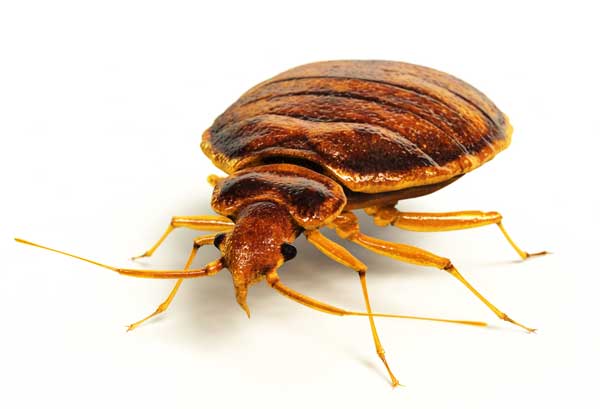
BEd Bugs
If you are currently experiencing bed bugs please call EcoShield today for a FREE No-Obligation estimate. Our bed bug service is guaranteed to eliminate bed bugs from your home.
Bed bugs are one of the worst infestations you can have. These pesky pests feed on blood and can live up to a year without a meal. They reproduce quickly and hide away for so long that by the time you notice you’re infested, the infestation could be at a very high level.
EcoShield Pest Solutions can help eliminate your bed bug problem. Our experts are trained to effectively remove bed bugs from your home without endangering your family or pets. If you have any signs of a bed bug infestation, please call now since it will get progressively worse over time and DIY solutions are ineffective against bed bugs.
Schedule a FREE Estimate
What are bed bugs?
Biology
Bed bugs belong to the family of insects known as Cimicidae. Cimicidae are a family of small parasitic insects that feed exclusively on the blood of warm-blooded animals, which is necessary for them to develop and reproduce.
All cimicids are small, oval-shaped, and flat in appearance, although their bodies bulge after feeding. They do not fly but do have small, nonfunctional wing pads. They also have beak-like mouth parts which they use to pierce the skin and suck the blood of their hosts.
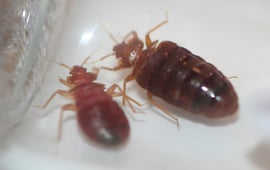 Lifecycle
Lifecycle
A bed bug’s life begins with an egg that is grain like and milky white in color. Female bed bugs lay between one and five eggs each day and may lie up to 500 eggs within one lifetime. Eggs are laid singly or in clusters and are placed within tight cracks or crevices. The egg is approximately 1 mm in length and is comparable in size to two grains of salt or a speck of dust. Within two weeks, the eggs hatch, and immature bed bugs begin immediately to feed.
Mature bedbugs are reddish brown in color, flattened, and wingless. The pests are oval-shaped and approximately 4-5 mm long and can run quickly. It’s color deepens to red-brown after dining on a blood meal. Usually the bed bugs are flat from top to bottom but will balloon up when filled with blood. Adults can live an average of up to 1 year and feed every 5 to 10 days. Eggs aren’t easily visible because of being cream colored and tiny (as in 1mm in length).
Since they do not have wings they cannot fly, but they do move quickly over floors, walls, and ceilings.
Feeding
The five nymphal instars (stages) must each take a blood meal to develop to the next stage. As the bed bugs continue to develop, they become larger and become darker until they reach adulthood. Adults have been reported to live 3-12 months in an untreated household situation.
A given undisturbed bug may take 3-15 minutes to take a full meal, depending on its life stage. Bed bugs can also survive prolonged periods of time without feeding, reappearing from their hiding places when hosts again become available.
Anatomy
Below is an illustration showing the parts of an adult bed bug’s body.
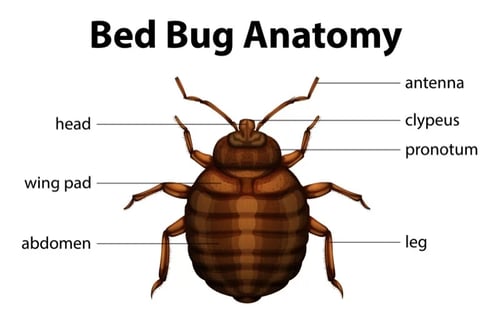
What do bed bug bites look like?
You will not see bed bugs living on your body. Unlike lice and the mites that cause scabies, bed bugs do not live on humans. Bed bugs come out of hiding to feed on human blood in order to survive, and the feeding lasts about 4 to 12 minutes. After a bedbug feeds, it returns to its hiding place.
The first time you are bitten, the bites may not itch right away. It can take time for your body to develop a reaction to the bites. Some people develop itchy welts within a few days of the first bites, but it can take as long as 14 days before the bites itch.
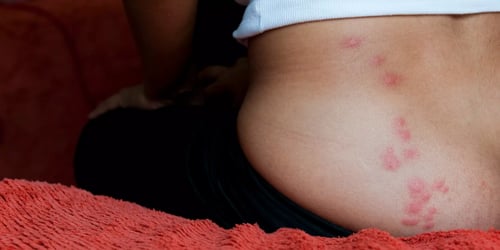
Some people also will not experience a reaction to a bed bug bite at all. Those that do experience symptoms of a bite are likely to experience one or more of the following:
-
a bite with a red, swollen area and a dark red center
-
bites in a line or grouped together in a small area
-
blisters or hives at the bite site
Bites can happen anywhere on the body. Most commonly, they occur on areas of skin that are exposed while sleeping, such as the face, arms, legs, and hands.
There are currently a couple of explanations for why bites often appear in rows:
The first theory is that they feed while you are sleeping and when you move or twitch and the bug will remove its mouthparts from your skin. When you stop moving the bug crawls a short distance and bites again; this can result in one bug leaving several bites in a row.
Another theory is that you lay on a crease in your sheets and there could be several bugs in that crease. As you lay there the bugs bite at the same time which leaves a row of bite marks.
Just because you have several bites, this does not dictate the number of bugs you have. The theories above just show ways in which you can have rows of bite marks.
Also, it is important to realize that medical professionals cannot give a positive diagnosis simply by examining bite symptoms, they can only suggest some possible explanations for what may have caused the bites/symptoms to occur.
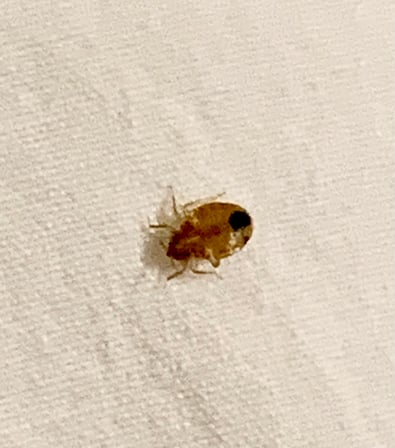
For a free no-obligation estimate, please give us a call or fill out the form on this page
If your bugs come back in between regular visits, we will return and service for FREE.
After two free re-services for the same guaranteed pest problem, if we don’t have your pests under control then we will credit 100% of your last full payment.
FREQUENTLY ASKED QUESTIONS
Since bed bugs hide and live in small and secluded places such as sheets and mattresses, in cracks and crevices, deep inside carpets, etc., a bug bomb (fogger) won't eliminate bed bugs. The bottom line is the aerosol mist from the fogger can't make its way into the cracks and crevices where the bed bugs live. Ohio State University conducted a...
Despite their young age, newly hatched bed bugs can survive for at least a few weeks without feeding. Adult bed bugs can survive for about five months without a blood meal.